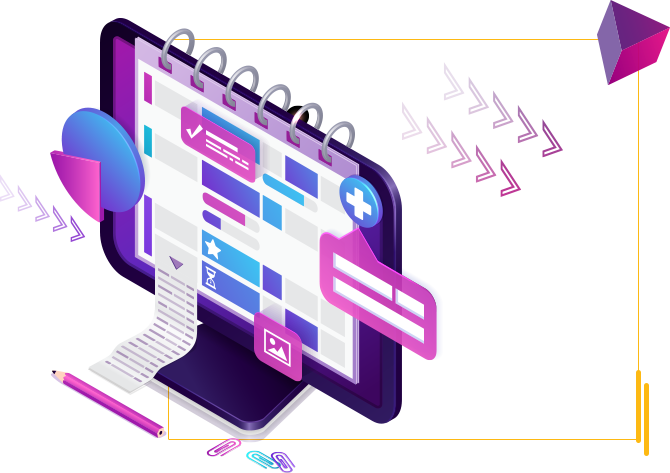
It is exciting and daunting at the same time to build a mobile app. You know the idea, the design, and the target audience. The single choice that makes or breaks your project, however, is the Tech Stack for Mobile App Development. The correct stack saves you money and time. It also ensures your app performs well and scales. The bad decision equals bugs, slowdowns, and endless frustration. So how do you make the right decision? Let’s take it apart step by step.
Why the Tech Stack for Mobile App Development Matters
The tech stack is similar to the foundation of a house. If it’s solid, your app is solid. If it’s not solid, cracks appear soon. Your app must run quickly and remain secure. It must also be adaptive to updates and changes. A good stack addresses both. It makes it easier for your developers to work, and it makes your users happy.
Who Are We?
We cater to all your business needs from digital
marketing to website development!

Top Factors to Look at When Choosing a Tech Stack
Performance and Speed
Your application must load quickly and function without delay. Users bounce if an app is sluggish or freezes. The stack you choose must be able to deliver fast response times and smooth performance.
Scalability
What if your app increases from 100 users to 10,000 users? Your stack has to endure growth without breaking. That is, it should be able to accommodate small changes as well as great ones.
Development Cost and Time
Budgets are important. Some stacks take more time and money than others. For instance, native app development is more expensive but offers the best performance. Cross-platform is inexpensive but potentially requires sacrifices.
Security
All apps gather data. Security cannot be an afterthought. Your tech stack must include native encryption tools and secure user login tools. If your app isn’t secure, people will depart, and trust will be lost.
Native vs Cross-Platform Development
Native Development
Native apps are developed for one platform. If you choose iOS, you develop with Swift or Objective-C. If you choose Android, you develop with Kotlin or Java. The advantages are speed and stability. The disadvantages are increased expense and longer schedules.
Cross-Platform Development
Cross-platform apps execute on iOS as well as Android. This is possible due to tools such as Flutter and React Native. The advantages are reduced expense and quicker delivery. The disadvantages are that you’ll lose some capability and functionality.
Grow Human-Centered
Businesses
Online
Web App Vault is a custom web design and business
website development company that enhances the visibility
and credibility of businesses. We are an approachable
eCommerce service provider that fuels digital marketing.
We Are Here To Help
Web App Vault – Your
Industry-Specific
Data Guardian
Our industry-specific web application solution
provides robust data security and a seamless user
experience tailored to your industry’s requirements.
Safeguard your sensitive data with assurance.

Popular Frameworks in Mobile App Development
Flutter
Flutter is supported by Google. It allows you to create both iOS and Android apps using a single codebase. The interface is up-to-date-looking and also fast. It is ideal for startups that need to get up and running quickly.
React Native
React Native is supported by Meta. It is favored because it is based on JavaScript, which developers already know. It is ideal for apps that require speed and adaptability.
Swift for iOS
Swift is the language of choice for iOS applications. It’s fast, secure, and new. If your audience is iPhone users, Swift is a good option.
Kotlin for Android
Kotlin has become the language of choice for Android applications. It’s easy to code and easy to maintain. It’s also great to work with Java, so it’s flexible.
Backend Technologies
Node.js
Node.js is quick and suitable for apps requiring real-time capabilities. It’s lightweight and scalable.
Django
Django is based on Python. It is secure and simple to implement. It is excellent for apps dealing with sensitive information, such as payments or health records.
Databases for Mobile Apps
SQL Databases
SQL choices such as PostgreSQL and MySQL are ordered. They are excellent for apps with grouped data.
NoSQL Databases
NoSQL solutions such as MongoDB are adaptable. They suit apps with unstructured data, such as logs or chats.
Selecting the Ideal Pairing
Features vs Budget
If budget is not an issue, native development could be ideal. If one prefers to spend less and roll out quickly, cross-platform is the way to go.
Short-Term vs Long-Term Objectives
If you must have an MVP fast, use cross-platform technologies like Flutter. If you’re willing to spend on long-term performance, go native with Swift or Kotlin.
Common Errors in Picking a Tech Stack
Not Considering the Target Audience
If your users are predominantly iPhone users, begin with iOS first. If they’re Android users, begin with Kotlin.
Blindly Copying Competitors
Avoid blind copying competitors without research.
Your competitor’s stack may not fit your goals. Do your research. Think about your app’s needs before choosing.
Forgetting About Maintenance
Your stack should be easy to maintain. Hard-to-maintain stacks cost more in the long run.
Future Event: What Trends to Watch Out For
Low-Code Platforms
These allow faster app development with less coding. They are growing fast and will likely become more common.
Cloud-Based Development
Cloud tools enable apps to be scaled and secured more easily. They also facilitate easier collaboration among developers.
Testing and Quality Assurance Matter
The greatest tech stack is worthless without testing. Your developers need to test features step by step and not just at the end. Testing saves time and avoids costly fixes down the road.
There are two aspects to look at. First is functionality testing to ensure features function as intended. Second is user experience testing to verify how seamless the app feels for actual users. Both are equally important.
Automated tests are useful when you design frequent updates. Manual testing is useful when you want to know how users interact with the app. A good tech stack accommodates both. Skipping tests is similar to skipping brakes on a car. You may go fast, but you are traveling for trouble.
Conclusion
The Mobile App Development Tech Stack is not a hasty choice. Your decision impacts performance and price. It also influences security and scalability. Consider your users and your objectives. Choose between cross-platform and native. Select the correct backend and database. Be aware of pitfalls and look out for emerging trends. With the appropriate stack, your app can develop strongly and dominate the market.
FAQs
1. What is the single most critical consideration when selecting a mobile app development tech stack?
Your project requirements are the most critical consideration. For instance, if you require high performance, then a native stack would be ideal. If you require quicker delivery, then hybrid frameworks are fine.
2. Am I able to alter my tech stack once the app has gone live?
It can be done, but it might be costly and time-consuming. That is why it is preferable to select the correct tech stack in the first place. Planning carefully helps save you both effort and money later on.
3. Are native or cross-platform development options preferred by startups?
Startups tend to choose cross-platform development because it is time and cost-saving. Native apps, on the other hand, offer better performance and greater access to native device features. The decision is based on your business objectives and resources.
